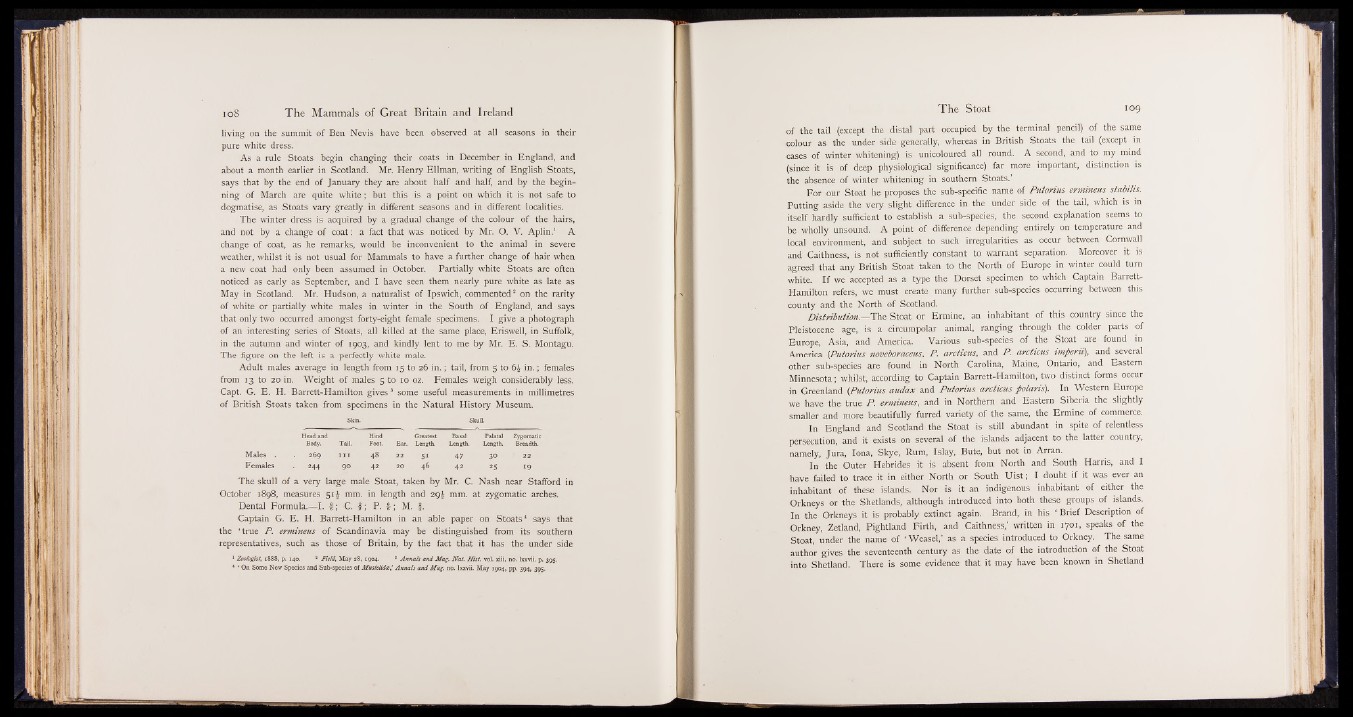
living on the summit of Ben Nevis have been observed at all seasons in their
pure white dress.
As a rule Stoats begin changing their coats in December in England, and
about a month earlier in Scotland. Mr. Henry Ellman, writing of English Stoats,
says that by the end of January they are about half and half, and by the beginning
of March are quite white; but this is a point on which it is not safe to
dogmatise, as Stoats vary greatly in different seasons and in different localities.
The winter dress is acquired by a gradual change of the colour of the hairs,
and not by a change of coat: a fact that was noticed by Mr. O, V. Aplin.1 A
change of coat, as he remarks, would be inconvenient to the animal in severe
weather, whilst it is not usual for Mammals to have a further change of hair when
a new coat had only been assumed in October. Partially white Stoats are often
noticed as early as September, and I have seen them nearly pure white as late as
May in Scotland. Mr. Hudson, a naturalist of Ipswich, commented2 on the rarity
of white or partially white males in winter in the South of England, and says
that only two occurred amongst forty-eight female specimens. I give a photograph
of an interesting series of Stoats, all killed at the same place, Eriswell, in Suffolk,
in the autumn and winter of 1903, and kindly lent to me by Mr. E. S. Montagu.
The figure on the left is a perfectly white male.
Adult males average in length from 15 to 26 in .; tail, from 5 to 6£ in .; females
from 13 to 20 in. Weight of males 5 to 10 oz. Females weigh considerably less.
Capt. G. E . H. Barrett-Hamilton g ives8 some useful measurements in millimetres
of British Stoats taken from specimens in the Natural History Museum.
Skin. Skull.
Head and Hind Greatest Basal Palatal Zygomatic
Body. Tail. Foot Ear. Length. Length. Length. Breadth.
Males | 269 I l l 48 22; 51 47 30 22
Females 244 90 42 2 0 46 42 25 19
The skull of a very large male Stoat, taken by Mr. C. Nash near Stafford in
October 1898, measures 51 £ mm. in length and 29^ mm. at zygomatic arches.
Dental Formula.— I. £ ; C. f ; P. I ; M. f .
Captain G. E . H. Barrett-Hamilton in an able paper on Stoats4 says that
the ‘ true P . ermineus of Scandinavia may be distinguished from its southern
representatives, such as those of Britain, by the fact that it has the under side
1 Zoologist, 1888, p. 140. * Field, May 28, 1904. 3 Annals and Mag. Nat. Hist. vol. xiii. no. Ixxvii. p. 395.
* 1 On Some New Species and Sub-species of Mustelida,’ Annals and Mag. no. Ixxvii. May 1904, pp. 394, 395.
of the tail (except the distal part oieupied by the terminal pencil): of the same
colour as the under side generally, whereas in British Stoats the tail (except in
cases of winter whitening) is unicoloured all round. A second, and to my mind
(since it is of deep physiological significance) far more important, distinction is
the absence of winter whitening in southern Stoats.’
For our Stoat he proposes the sub-specific name of Putorius ermineus statnlis.
Putting aside the very slight difference in the under side of the tail, which is in
itself hardly sufficient to. establish a sub-speeie% the B X ttd explanation seems to
fe wholly unsound. A point of difference depending entirely on temperature and
local environment, and subject pro such irregularities: as occur between Cornwall
and Caithness, is not sufficiently constant to warrant separation. Moreover it id
agreed that any British Stoat taken » t h e North of Europe in winter could turn
white. I f we accepted as a type the; Dorset specimen to-which Captain Barrett-
Hamilton refers, we must create many further sub-species occurring between thid
county and the North of Scotland.
D istribution.—The Stoat or Ermine, an inhabitant of this country since the
Pleistocene age, is a circumpolar animal, ranging through the colder parts of
.Europe, Asia, and America|;i:J Various siA-Species of the Stoat are found in
America (Putorius noveboracens, P . arcticus, and P . arcticus im perii), and several
other sub-species are found in North Carolina, Maine, Ontari<|||j and Eastern
Minnesota; whilst, according to Captain Barrett-Hamilton, two distinct forms|gcur
in Greenland (Putorius audax and Putorius arcticus fo la ris). In Western Europe
we have the true P . ermineus, and in Northern and Eastern Siberia the slightly
smaller and more beautifully furred variety of the same, .the Ermine of commerce.
In England and Scotland the Stoat still abundant in spite of relentless
persecution, and it exists on several of the islands adjacent to the latter country,
namely, Jura, Iona, Skye, Rum, Islay, Bute, but not in Arran.
In the Outer Hebrides, it is absent from North and . South Harris, and I
have failed to trace it in either North or South Uist; I doubt if it was ever an
inhabitant of these islands. Nor is it an indigenous inhabitant of either the
Orkneys or the ShetlanH although introduced into both these groups of islands.
In the Orkneys it is probably extinct again. Brand, in his ‘ Brief Description of
Orkney, Zetland, Pightlan||Firth, and Caithness,’ written in 1701, speaks ojtvthe
Stoat, under the name o f ‘ Weasel,’ a species introduced to Orkney. The same
author gives the seventeenth century as the date of the introduction of the Stoat
into Shetland. There is some evidence that it may have been known in Shetland